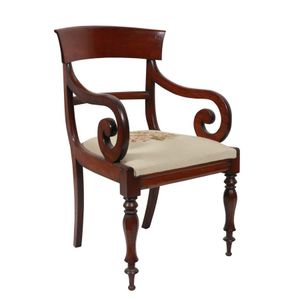Anglo-Indian Colonial Chairs (Pair)
Pair of British Colonial chairs Anglo-Indian, mid 19th century each with woven cane seat, scrolled arms, raised on tapered legs (2). Height 83 cm. Width 58 cm. Depth 44.8 cm. provenance: Purchased from Neumann Antiques, 4 March 1963
You must be a subscriber, and be logged in to view price and dealer details.
Subscribe Now to view actual auction price for this item
When you subscribe, you have the option of setting the currency in which to display prices to $Au, $US, $NZ or Stg.
This item has been sold, and the description, image and price are for reference purposes only.
- Cane in Furniture Making - Cane, as used to make furniture is harvested from the ratan palm. The rattan palm is a type of climbing palm that is native to tropical regions of Asia and Africa. The stem of the rattan palm, also known as cane, is harvested, stripped of its skin, and then used to make a variety of furniture items. Rattan furniture is known for its durability, lightness and natural beauty. The cane is flexible yet strong and can be woven into various patterns, making it suitable for a wide range of furniture styles from traditional to modern. The furniture made from rattan cane is also known for its durability and resistance to extreme weather conditions. Popular items include chairs, tables, sofas, and cabinets. The natural colour of the cane can be preserved or it can be stained or painted for different looks.
- Provenance - A term used to describe the provable history of an antique or work of art, and thus an additional aid to verifying its authenticity. Provenance can have an inflating effect on the price of an item, particularly if the provenance relates to the early settlement of Australia, a famous person, or royalty. Less significant are previous sales of the item through an auction house or dealer.
- Tapered Legs - found on both cabinet and country-made furniture from the 18th to the later 19th centuries. The leg sometimes terminates in a spade foot, though on most country furniture the taper continues for the whole length of the leg. The important thing to remember is that the taper ought only to be on the inside face of the leg, and the outer face should be straight and square. Some legs were made where both sides tapered, but in such a case the taper ought to be the same on both the inner and outer faces of the leg. Where the inside of a leg is straight, with only the outer face tapering, there is every reason to be suspicious
This item has been included into following indexes:
- Anglo-Indian - furniture, chairs 61
- Anglo-Indian Vizagapatam and sadeli boxes - sewing and other boxes 323
-
chairs, singles / pairs / threes, style or period
- Colonial 108
- Victorian, other styles 1,179
Visually similar items

A Victorian mahogany armchair, with carved column legs 85 x 55 x 52 cm
Sold by
in
for
You can display prices in $Au, $US, $NZ or Stg.

Two Australian Colonial cedar side chairs, 19th century, each with a curved top rail, solid seat, on turned tapering legs (2), height 88 cm, 86 cm
Sold by
in
for
You can display prices in $Au, $US, $NZ or Stg.

Victorian armchair cedar spade back, tapestry upholstery, & octagonal tulip legs
Sold by
in
for
You can display prices in $Au, $US, $NZ or Stg.

Child's high chair, Australian cedar, mid 19th century.
Sold by
in
for
You can display prices in $Au, $US, $NZ or Stg.
